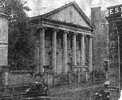 Nottingham Nottingham
St Thomas
History
Led by Richard Mercer a further group separated from the main body of Wesleyanism
and built this large chapel in Park Row. It opened for worship on 8th April
1855, as the Wesleyan Congregational Free Church, when the Rev H Breedon, Wesleyan
Associate Minister, preached two sermons. It could seat about 800 persons.
The cost was £3,000, largely donated by Mr Mercer. He appears to
have dominated the society so that it became known as ‘Mercer’s
Chapel’. But it had only a very short life and in 1857 was put up for
sale, on condition that Mercer should be allotted a pew as his freehold for
ever. For a few years various denominations used the chapel on a temporary
basis.’
Then, in the early 1870s, it was purchased by the Church of England. The site
was bought from the owners, Thomas Adams, William Windley and the Rev Henry
Wright, for £2,500. Adams and Wright each donated £250 for church
building. The Rev Walter Senior, who was the Chaplain to Thomas Adams’ warehouse
on Stoney Street, agreed to be the first incumbent.
T C Hine was engaged to make considerable changes. After submitting his designs to
the Ecclesiastical Commissioners he received a reply from Ewan Christian, their
architectural adviser, in May 1872. He had no objection to structural changes
except that lateral walls were to be strengthened with piers. The chancel was
too cluttered so pews were to be re-arranged and the pulpit and desk were to
be moved; also a separate entrance from church to vestry was required. The
rich ornamentation introduced at this time has already been noted. The elaborate
decoration of walls and ceiling was undertaken by Mr G Sparrow, churchwarden,
as a gift to the church.
The Episcopal Church of St Thomas, as it was to be called, was consecrated
by the Bishop of Lincoln on 22nd April 1873. At his request all 600 seats were
to be free. A large and poor population between Market Street and Parliament
Street, which had previously been neglected, was to be included in the New
District. At the same time it was hoped to include an area capable of providing
teachers and parochial workers.
The Consolidated Chapelry was to be taken partly from the parish of St Matthew,
partly from St Nicholas’ and partly from Holy Trinity, a total of 26½
acres with a population of just over 4,000. A Plan of the District was drawn
up by Fothergill Watson in July 1873. The Ecclesiastical Commission objected
to the inclusion of a part nearer to Holy Trinity than to St Thomas’, ie between
Upper Parliament Street, Milton Street and North Street. It was left out, but
a small part of St Peter’s parish
near Bromley House was included. Arguments over boundaries continued until
the Rev Mr Senior complained to the Bishop that the Ecclesiastical Commission’s
proposals were impossible. The Bishop intervened, and a line drawn between
the backs of houses and courts lying between Mount Street and St James’ was
finally accepted.
Thus Fothergill Watson drew up another plan in June 1874, stretching to Clumber
Street, Wollaton Street, Chapel Bar and Park Row. Then he completed a final
map detailing the boundary of the contentious area around Mount Street. This
was accepted and the District was finally assigned in July 1874.
A few months later the church was offered anonymously almost 1,000 square
yards of land at the corner of The Ropewalk and Oxford Street for a parsonage.
This was built in 1888 at a cost of £2,247, including £1,000 from
the Ecclesiastical Commissioners. The same anonymous donor offered £544
towards a stipend for the Curate and, from 1st May 1875, the Commissioners
granted £200 pa for the Income of the Cure.
There were additions to the church at the end of the century. In 1898-99 a
chancel screen was erected, the organ enlarged and
a font cover provided. Also, four new clerestory
windows were inserted. Nevertheless, open air services were still taking place
in 1907 in Courts and Yards of the parish.
The closure of St Thomas’ was proposed in early 1922 by the Bishop’s
Commission, much to the dismay of the Vicar, Rev Charles Davis, and his parishioners.
He got up petitions to protest, saying that the church had never been in financial
difficulties and should not be converted into a Church Hall as proposed. In
spite of his efforts the Privy Council’s decision to close St Thomas’ was
announced in December 1925, although it was not to take place during Mr Davis’
incumbency. He believed it was being closed because it was evangelical.
When the Rev Charles Davis died in 1926 St Thomas’ was made a Chapel
of Ease in the parish of St Matthew. It closed soon afterwards and was
demolished in 1930-31. (The site was used for the Diocesan Church House, built
in 1932.) The oak lectern, font and communion vessels were presented to St Barnabas’
Church, Lenton Abbey, and the pews went to St Paul’s, Carlton-in-the-Willows.
Other furniture and fittings were appropriated by the Bishop of Southwell and
disposed of as he saw fit.
Relevant Dates
1855Built as The Wesleyan
Congregational Free Church
1873Purchased by the Church
of England and converted into the Episcopal Church of St Thomas. Consecrated
22nd April 1873
1873Alterations by T C Hine
1874New District Chapelry
assigned in July
1899Chancel screen and clerestory
windows added
1926Merged with St Matthew’s
Church and closed
1930-31Demolished
| 




